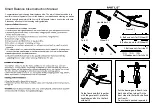
GDMUSK700E-2G
Version 0010
14
5.8.2
Take-Off
Use the foot pedal to progressively attain full throttle when carrying a passenger.
When flying solo, 3/4 throttle will be enough for take-off and climbing. Use full power
only under critical conditions (short take-off runs, obstacles and high altitude flight). In
this case
never reduce or cut the engine
below the 300 ft (100 m) altitude to avoid
dynamic stalling.
The recommended speed for initial climb is indicated in the wing’s manual.
5.8.3
Cruising
Keep the aircraft level with the throttle between ¼ and full power, depending on given
airspeed and load. Avoid repeated and sudden power climbs and idle dives to prevent
quick engine temperature changes, which could damage the engine by thermal shock. To
avoid permanent pressure on the right foot throttle, push the hand lever on the right of the
control panel until it resists, then release the pedal. To return to pedal control, press the
pedal until it resists, then pull back the lever.
Fuel tank content is easy to check from pilot’s and passenger’s seats as the tank has a side
gauge, or the optional electric gauge. A landing should be considered before tank
contents reach 1.5 US gallons (5 liters). This allows approximately 30 minutes reserve of
flight at economical cruising speed.
5.8.4
Landing
The landing approach is best executed using the foot throttle pedal and both hands on the
control bar. At maximum load, keep the throttle at ¼ of full power when on final to
facilitate flare-out. Throttle back when the wheels touch the ground.
The recommended approach speed is indicated in the instruction and maintenance manual
of the wing.
5.8.5
Parking
1. Park the aircraft in the crosswind and place the extremity of the half-wing in the wind on the
ground.
2. Turn off electronic instruments.
3. Stop the engine with the ignition switch.
4. Cut the battery power using the key.
5. Block the parking brake.
6. Block the control bar on the front strut of the trike using Velcro strap.
7. Leave the trike, pilot first, then passenger, and always to the left side.






































